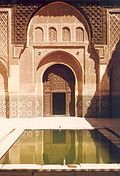
Ben Youssef Medrassa
Encyclopedia


College
A college is an educational institution or a constituent part of an educational institution. Usage varies in English-speaking nations...
in Marrakech
Marrakech
Marrakech or Marrakesh , known as the "Ochre city", is the most important former imperial city in Morocco's history...
, Morocco
Morocco
Morocco , officially the Kingdom of Morocco , is a country located in North Africa. It has a population of more than 32 million and an area of 710,850 km², and also primarily administers the disputed region of the Western Sahara...
, named after the Almoravid sultan
Sultan
Sultan is a title with several historical meanings. Originally, it was an Arabic language abstract noun meaning "strength", "authority", "rulership", and "dictatorship", derived from the masdar سلطة , meaning "authority" or "power". Later, it came to be used as the title of certain rulers who...
Ali ibn Yusuf
Ali ibn Yusuf
Ali ibn Yusuf was the 5th Almoravid king he reigned 1106–1143.-Biography:Ali was recognized as the heir of his father Yusuf ibn Tashfin in 1102. He succeeded his father upon his death in 1106. Ali ruled from Morocco and appointed his brother Tamin ibn Yusuf as governor of Al-Andalus...
(reigned 1106–1142), who expanded the city and its influence considerably. It is the largest Medrasa in all of Morocco.
The college was founded during the period of the Marinid
Marinid
The Marinid dynasty or Benemerine dynasty was a Zenata Berber dynasty of Morocco. The Marinid dynasty overtook the Almohads in controlling Morocco in 1244. They controlled most of the Maghreb from the mid-14th century to the 15th century and supported the Kingdom of Granada in Al-Andalus in the...
(14th century) by the Marinid
Marinid
The Marinid dynasty or Benemerine dynasty was a Zenata Berber dynasty of Morocco. The Marinid dynasty overtook the Almohads in controlling Morocco in 1244. They controlled most of the Maghreb from the mid-14th century to the 15th century and supported the Kingdom of Granada in Al-Andalus in the...
sultan Abu al-Hassan and allied to the neighbouring Ben Youssef Mosque. The building of the madrasa was re-constructed by the Saadian
Saadi Dynasty
The Saadi dynasty of Morocco , began with the reign of Sultan Mohammed ash-Sheikh in 1554, when he vanquished the last Wattasids at the Battle of Tadla....
Sultan Abdallah al-Ghalib
Abdallah al-Ghalib
Abdallah al-Ghalib Billah was the second Saadian sultan of Morocco.He came to power to the throne as the legal heir of Mohammed ash-Sheikh. From his first wife this first Saadian sultan, Mohammed ash-Sheikh had had three sons, but the two oldest had died...
(1557–1574). In 1565 the works ordered by Abdallah al-Ghalib
Abdallah al-Ghalib
Abdallah al-Ghalib Billah was the second Saadian sultan of Morocco.He came to power to the throne as the legal heir of Mohammed ash-Sheikh. From his first wife this first Saadian sultan, Mohammed ash-Sheikh had had three sons, but the two oldest had died...
were finished, as confirmed by the inscription in the prayer room. Its 130 student dormitory cells cluster around a courtyard richly carved in cedar, marble
Marble
Marble is a metamorphic rock composed of recrystallized carbonate minerals, most commonly calcite or dolomite.Geologists use the term "marble" to refer to metamorphosed limestone; however stonemasons use the term more broadly to encompass unmetamorphosed limestone.Marble is commonly used for...
and stucco
Stucco
Stucco or render is a material made of an aggregate, a binder, and water. Stucco is applied wet and hardens to a very dense solid. It is used as decorative coating for walls and ceilings and as a sculptural and artistic material in architecture...
. The carvings contain no representation of humans or animals as required by Islam
Islam
Islam . The most common are and . : Arabic pronunciation varies regionally. The first vowel ranges from ~~. The second vowel ranges from ~~~...
, and consist entirely of inscriptions and geometric patterns. This madrasa was one of the largest theological colleges in North Africa
North Africa
North Africa or Northern Africa is the northernmost region of the African continent, linked by the Sahara to Sub-Saharan Africa. Geopolitically, the United Nations definition of Northern Africa includes eight countries or territories; Algeria, Egypt, Libya, Morocco, South Sudan, Sudan, Tunisia, and...
and may have housed as many as 900 students. One of its best known teachers was Mohammed al-Ifrani
Mohammed al-Ifrani
Mohammed al-Ifrani was a Moroccan historian. He is noted as the author of Safwat man intashar, a compilation of biographies of 17th century Morrocan saints, as well as his 1724 history of the Saadi Dynasty.-External Links:...
(1670-1745).
Closed down in 1960, the building was refurbished and reopened to the public as a historical site in 1982.
See also
- Saadi DynastySaadi DynastyThe Saadi dynasty of Morocco , began with the reign of Sultan Mohammed ash-Sheikh in 1554, when he vanquished the last Wattasids at the Battle of Tadla....
- Bou Inania Madrasa in FesFes, MoroccoFes or Fez is the second largest city of Morocco, after Casablanca, with a population of approximately 1 million . It is the capital of the Fès-Boulemane region....
- Bou Inania Madrasa (Meknes)
- Saadi DynastySaadi DynastyThe Saadi dynasty of Morocco , began with the reign of Sultan Mohammed ash-Sheikh in 1554, when he vanquished the last Wattasids at the Battle of Tadla....
- MarrakechMarrakechMarrakech or Marrakesh , known as the "Ochre city", is the most important former imperial city in Morocco's history...
- Shrob ou shouf fountainShrob ou shouf fountainThe Shrob ou shouf fountain is situated in the medina of Marrakech near the Ben Youssef Medrassa.-History:The fountain was built during the reign of the Saadian sultan Ahmad al-Mansur...
- El Badi PalaceEl Badi PalaceEl Badi Palace is located in Marrakech, Morocco, and these days it consists of the remnants of a palace commissioned by the Saadian Sultan Ahmad al-Mansur in 1578...
- Saadian TombsSaadian TombsThe Saadian tombs in Marrakech date back from the time of the sultan Ahmad al-Mansur . The tombs were only recently discovered and were restored by the Beaux-arts service...

